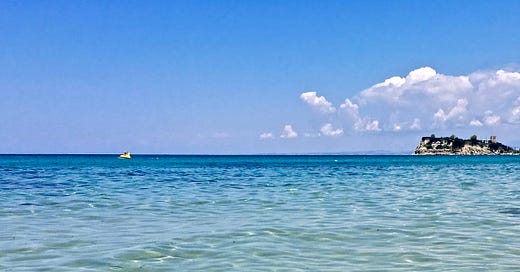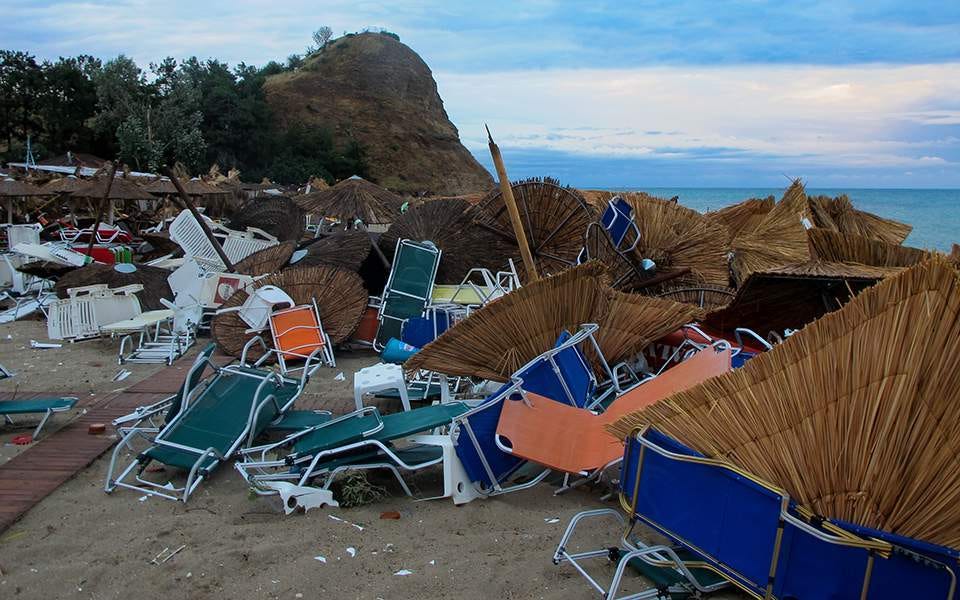Remember early this month when we were all talking about Burning Man? Climate activists blocked access to the arts festival, denouncing the event as a polluting bacchanal for the ultra-wealthy. Just a couple of days later, unprecedented rain made a muddy mess of Burning Man, marooning 70,000 festival-goers at the site. Everyone had a take.
Many saw Burning Man as a climate crisis parable: ignore climate change activists and suffer an extreme weather event. Mother Nature had her revenge on those privileged polluters, the story went.
Reducing the festival’s carbon footprint and improving its sustainability are important, but the moralizing commentary obscured a larger issue: Extreme weather is increasingly jeopardizing outdoor events.
That larger issue is the subject of a valuable September 13th Pitchfork report by Philip Sherburne, “Music Festivals in a Time of Extreme Weather.” Sherburne opens with a scene from the fearsome Red Rocks Amphitheater hailstorm in June that left dozens injured. He then zooms out for a global view:
The Red Rocks debacle was a particularly dramatic example of how extreme weather is wreaking havoc on outdoor events. This summer alone, Primavera Sound Madrid, Tennessee’s Bonnaroo, German metal festival Wacken Open Air, Scottish folk festival Tiree, Michigan rave Electric Forest, and our own Pitchfork Music Festival were either paused, preempted, or aborted due to inclement weather. Unexpected rains turned Burning Man’s Mad Max desert cosplay into a mud-caked hellscape that forced the cancellation of events and the closure of roads (even Diplo and Chris Rock had to hitch a ride home). In Australia, heavy rains stoked by La Niña, a periodic weather phenomenon that climatologists say is exacerbated by ocean warming, recently forced the cancellation of more than a dozen music festivals. British Columbia’s Under the Stars was halted and evacuated last month after wildfires flared up nearby. Meanwhile, South Korea’s World Scout Jamboree suffered a heat wave that sickened hundreds, followed by a typhoon that forced its evacuation.
Outdoor festivals have always been close to nature, so extreme weather at these events isn’t new. The legendary Woodstock festival was about as muddy as this year’s Burning Man. What’s different now is the frequency and intensity of severe weather. The future that climate scientists warned of for decades? It seems to be here now.
Sherburne covers how festival organizers are grappling with this new normal: moving festivals from the summer to less tempestuous shoulder seasons, making trial site evacuations, buying more expensive insurance policies, and hiring “weather risk communicators.”
Of course, the recent climate event tragedy in Libya makes it feel a little frivolous to worry about outdoor music at all. For now, though, outdoor fests remain a summer rite of passage for millions around the world. So in an era of stronger and more frequent weather events creating festival disruptions, how will we festivate?
A freak storm on my way to the Sani Festival
In July 2019, I covered the Vitrin Showcase in Istanbul, then took a short flight to Greece to cover the Sani Festival. This unusual festival at the five-star Sani Resort in Halkidiki presents a single concert each night over just a couple of weekends. I was excited for the fest’s dramatic seaside setting and for a special performance by jazz titan Charles Lloyd involving his Sky Trio as well as Greek musicians Maria Farantouri, Takis Farazis, and Sokratis Sinopoulos.
With a few free days between the Vitrin and Sani events, I first visited Athens’ sites and museums; I met up with the marvelous pianist Tania Giannouli for dinner. Then I headed north to spend the three remaining nights before the fest in a coastal Airbnb near the Sani Resort in Halkidiki.
On my second night there, rain was forecast. So I had an early dinner and cycled through the pines to my Airbnb at sunset.
At dusk, rain arrived and the wind suddenly increased to a violent force. It was as if the Anemoi or four Greek wind gods were blowing some mad collective improvisation.
Given the unfamiliarity of the area and the near-darkness outside, I didn’t trust my perception of the weather. I thought I saw a deck chair fly across the patio. It can’t be that severe, I reasoned. Still, I closed the window shutters and headed to my garden-level space’s deepest corner where a chair and lamp were set up for reading. By the time the storm had blown over just 15 minutes later, night had fallen. I went to bed.
I woke to find the power out and my phone buzzing with concerned messages from my Greek friend Nikolas. Greek and international news was reporting the deaths of several people at nearby resorts (not at Sani, but close). The freak storm had taken even the poshest resorts by surprise; hundreds of affluent vacationers had been outside, exposed to flying debris when the storm charged in. As local old-timers would later confirm for me, a storm of this sudden ferocity was unprecedented in Halkidiki. They cited a spell of unusually hot weather in Northern Greece as the cause.
Of course, in my coastal Airbnb, I wasn’t at the Sani Festival quite yet, but I was in the area for the event.
In the Pitchfork report, one of Sherburne’s sources suggests that outdoor festivals and concerts have an active responsibility to discuss the impact of climate change and encourage their ticket-holders to be conscious of its effects, which would include severe weather.
Still, we can’t rely on event organizers, or anyone, for that matter, to tell us everything we need to know during extreme weather. Even in a relatively safe space, my disadvantage in the storm was having no clue about how the most basic things worked there. Where did the area’s power come from? Were there any generators? If I needed more drinking water, where could I get it?
I was wholly unprepared for these practical concerns. Most of my planning for the Aegean coast involved researching the best swimming beaches, listening to Charles Lloyd’s Athens Concert recording, and finding the right books to sustain my travel dream. For me, the magic of traveling to festivals has always involved the breezy fun of leaving some experience up to chance. We transcend mundane concerns at outdoor festivals and concerts; we’re transported by the collective experience of live music in the open air.
We festival-goers may no longer be able to afford such blitheness.
No one wants to take the fun out of outdoor music events by advocating a kind of prepper mindset. Festivals don’t allow most prepper survival kit items, anyway—try getting a folding shovel and pick into your next music fest. Yet a quick assessment upon arrival at a festival or concert site now makes good sense. What are the options for traveling in and out of the site? If we need to take shelter quickly, where would we go? The physical, functional world matters very much in extreme weather conditions.
A little knowledge and planning can go a long way toward avoiding hassles and injuries, should severe weather arrive. Then we can get back to following our bliss.
Coda: Artists Transmuting Tragedy
The Sani Festival was scheduled to begin two nights after Halkidiki’s freak storm. Organizers postponed Charles Lloyd’s concerts for a week out of respect for the lives lost at nearby resorts. I had no other plans for the two days before my flight home so I left my Airbnb and went to the Sani Resort as scheduled. Instead of gathering for festival concerts, musicians and other guests came together for a special dinner.
I had the good fortune to be seated next to Charles Lloyd’s wife Dorothy Darr, a painter, filmmaker, and awesome human being. Upon arrival at dinner, Dorothy announced that Charles wouldn’t be joining us because he wasn’t feeling well. When festival organizers inquired politely about his illness, she said, “It’s more of a spiritual problem. He’s unsettled by not performing as scheduled.”
Dorothy’s frankness was met with surprised silence from the dinner guests. After a while, everyone began talking again. I asked Dorothy about Charles’s response to the concert postponement.
“It wasn’t his choice,” she said. "Charles grew up in the South in the Jim Crow era. And is 81 years old. He knows how to transmute tragedy into meaningful art and reach people. What’s the use of devoting a life to improvised music like jazz if you’re not ready to dig deep in moments of crisis?”
Deciding how to proceed after severe weather is yet another issue festival organizers will increasingly confront. Just how soon should a show go on, and in what spirit?
Yo-Yo Ma was in town to perform with the Colorado Springs Symphony on 9/11. The concert went on as scheduled, though the program was changed to include Barber’s “Adagio for Strings.” After Hurricane Katrina, John Boutte sang Randy Newman’s “Louisiana, 1927,” changing lyrics for topical power. James Brown’s calming Boston show the evening after Martin Luther King’s assassination is legendary.
When extreme weather brings chaos and tragedy, maybe we can trust our veteran artists to make meaningful and even profound musical statements. Anyway, many tough calls are ahead for festival and concert organizers.
Charles played his Sani Festival show a week later. By then, I was back home tending my vegetable garden, reading aloud to my child, and slowly forgetting the surprise deadly storm in Halkidiki and its many implications for outdoor festivals and the role of artistic expression in times of climate crisis. Until I read Philip Sherburne’s Pitchfork report and wrote up these thoughts for you.
I heard Charles’s rescheduled concert was a special one.








